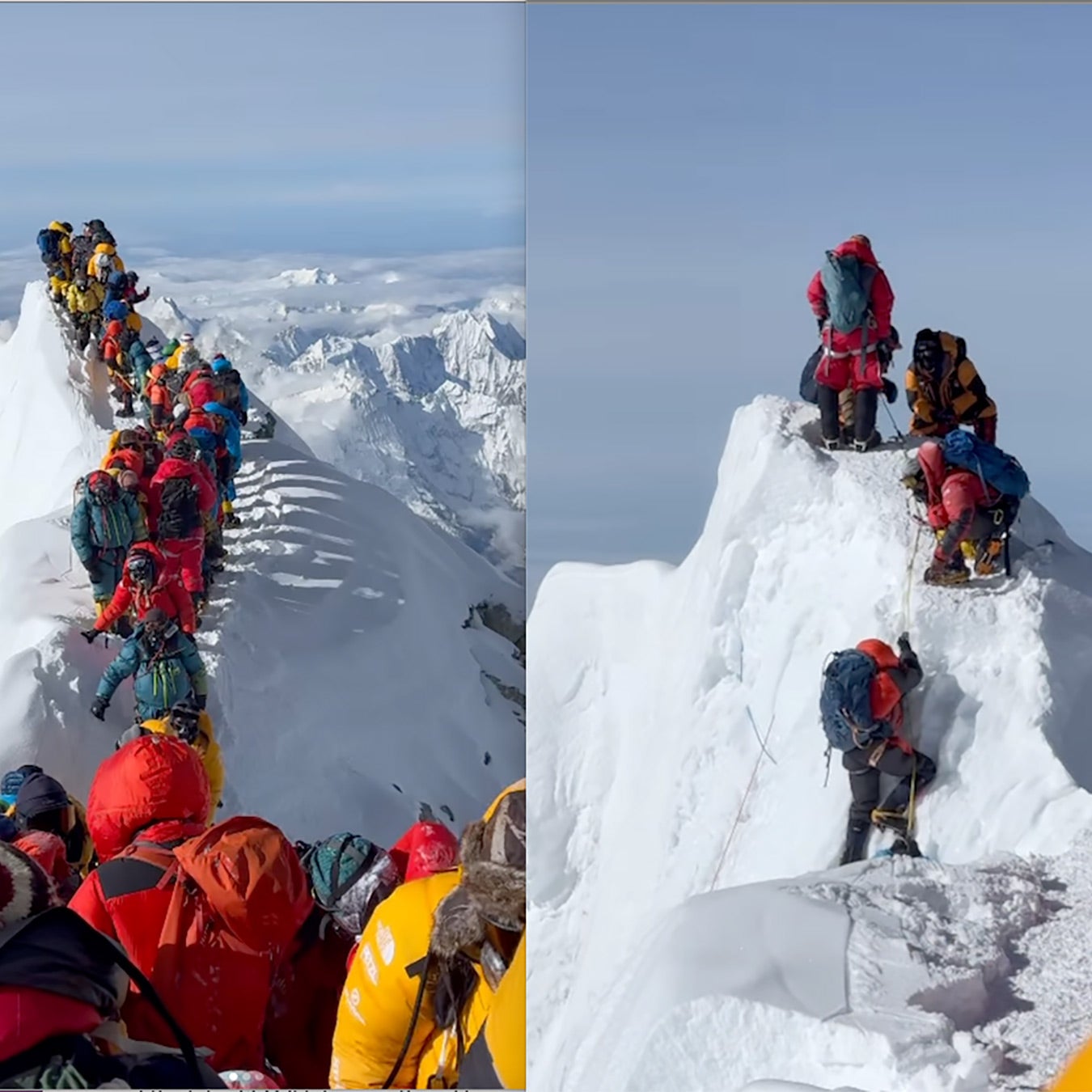At 6 A.M. on May 21, Nepali climbing guide gazed from the summit of Mount Everest for the fourth time in his life. The sun was cresting the horizon, its rays painting the peak’s eastern face in shades of orange and pink. Vinayak, who holds a certificate from the International Federation of Mountain Guides Association, marveled at the unusually high temperatures atop the mountain—it was so warm that he removed his gloves to snap photos of his client, a climber from Peru. The conditions were ideal for a summit push, and Vinayak predicted that the 100 or so climbers he’d seen the day before above Camp III would soon reach the top.
After 15 minutes, the two headed down toward the peak’s serrated summit ridge, which forms the international border between Nepal and China. The narrow and rocky section, usually scraped bare by wind, was covered in snow from a recent storm. The winds had sculpted the drifts into fin-like cornices that hung over the peak’s sheer Kangshung Face overlooking Tibet. They looked like gargoyles sitting atop a medieval cathedral.
After descending a few hundred feet, Malla abruptly halted. A massive group of climbers was trudging toward the summit on the knife edge. Both ascending and descending climbers were clipped into the same safety rope, and Vinayak knew that everyone would soon come to a standstill.
“The line was moving extremely slowly,” he said.
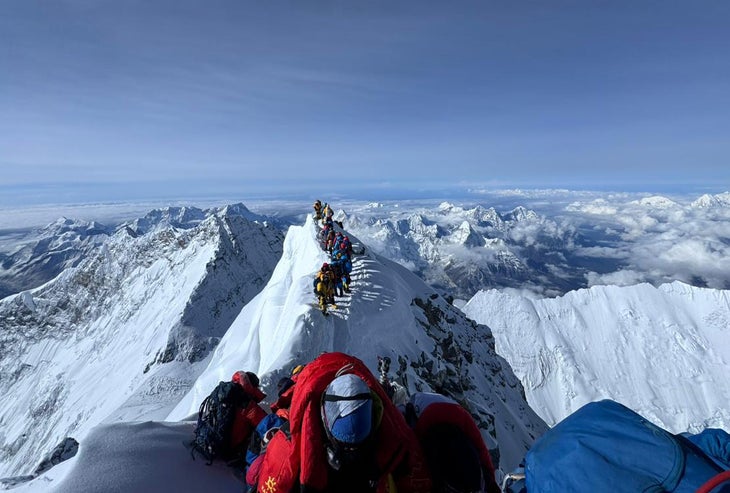
Ahead of Malla stood another descending climber, American Mark Baumgartner, a 49-year-old tech entrepreneur. He had just summited Everest, his first Himalayan peak, reaching the top alongside four guides and assistants.
Baumbartner told ���ϳԹ��� that he was unfazed by the traffic jam—the calm conditions kept his spirits high. “When the weather’s nice, a busy day means you go slower,” he said. “I was happy to go at the pace of the mountain.”
The ascending and descending climbers navigated the narrow section, carefully skirting each other while unclipping and then reclipping into the safety lines. The route took them over jagged rocks, chunks of ice, and the puffy snow cornices. Then the crowd heard a rumble. Without warning, one of the snow ridges detached from the rocks and plunged down the Kangshung Face.
“It felt like an earthquake,” Malla said. “There was a huge noise and everybody jumped back away from the cornice. I cried out because the mountain under us was shaking, but nobody could hear me. Everyone was terrified.”
Baumgartner heard the noise and looked at the ridge line ahead of him. A horrifying scene played out in slow motion: multiple climbers who had been standing on the ledge fell and began sliding downhill. He could see people grabbing the fixed line. “I assumed that everyone was clipped into the rope,” he says.
But not everyone was. Baumgartner stands six foot four, and from his vantage point he saw four of the climbers stop falling after the safety rope pulled tight. But two others continued sliding downward toward a sheer dropoff below.
“I was like holy shit— those people aren’t stopping,” he says. “Two people were sliding to their deaths. And it was silent.”
A Sheer Drop into China
Those who ascend Everest from the south side in Nepal must traverse the mountain’s daunting southeast ridge—the final section before the summit. Here, the route narrows after crossing the false south summit at 28,500 feet. Everyone’s pace slows due to the combination of thin air and traffic.
The route across the ridge shifts slightly each year due to snow conditions, wind, and rockfall. A major change to the route occurred during the 7.8-magnitude earthquake that struck Nepal in 2015. The infamous Hillary Step—a 40-foot vertical rock that Edmund Hillary and Tenzing Norgay famously shimmied up in 1953—partially collapsed, leaving a series of step-like rocks.
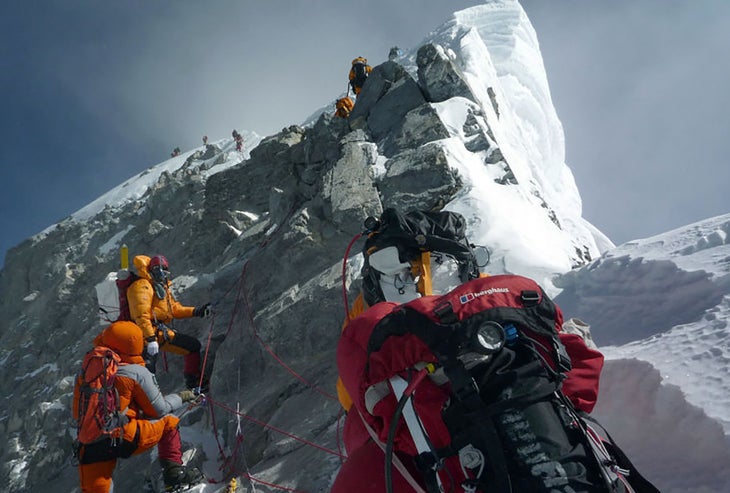
No matter the conditions, one element of the route is a constant: the sheer drop-off on either side of the knife edge. In some areas, the walking pathway is no wider than three feet. On one side is a plunge down wind-scoured rock into the Western Cym. On the other is the infamous Kangshung Face, a nearly vertical wall of rock and ice that plunges 11,000 feet to a glacier below.
“For a first-time Everest climber, the summit ridge might feel the same as the rest of the climb. But as an experienced guide, the dangers are obvious,” Malla said. “The soft snow and the cornices are the first thing you notice, and it’s quite scary.”
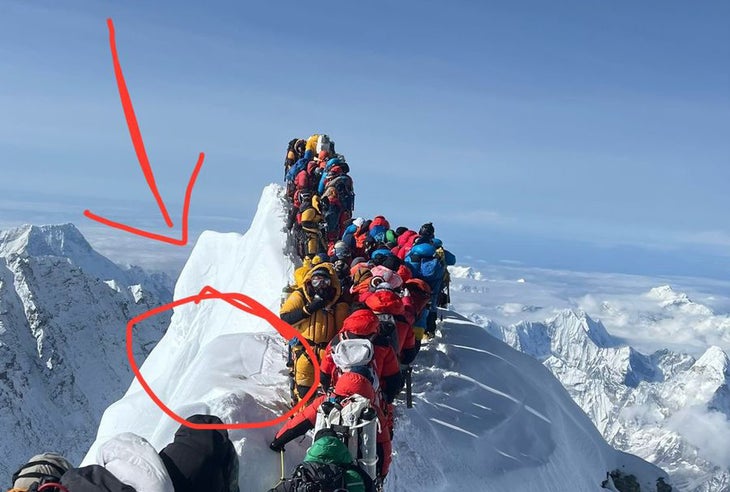
This spring, rope fixers encountered a relatively uncommon feature along the section: deep snow. Heavy precipitation deposited drifts on the ridge which were quickly flattened into a platform by the footfalls of the rope fixing team, allowing climbers to quickly and easily progress through the section.
Small groups of climbers pushed for the summit after workers completed the lines to the top on May 11. But strong winds and a violent storm kept most of the expedition operators grounded until the third week of May. That’s when a week of favorable conditions opened, prompting several hundred climbers and guides to push for the top.
Amid this rush to the summit, gridlock was inevitable. Guides told ���ϳԹ��� that in this situation they teach clients how to safely pass slower climbers or those descending from above. The maneuver involves unclipping themselves from the safety ropes as quickly as possible, making the pass, and then clipping back in. It’s an exercise that’s only done in areas where fall risk is minimal.
“You only overtake when absolutely necessary, and when the situation is safe to do so,” Malla explained. Often, a guide will attach a separate rope to the client as an extra safety precaution, so that one of them is always clipped in.
“We always use a guide rope or our safety line to attach the client to us,” Malla continued. “Ideally, when you have two guides, you attach on either side of the client so that someone is always connected to the fixed rope.”
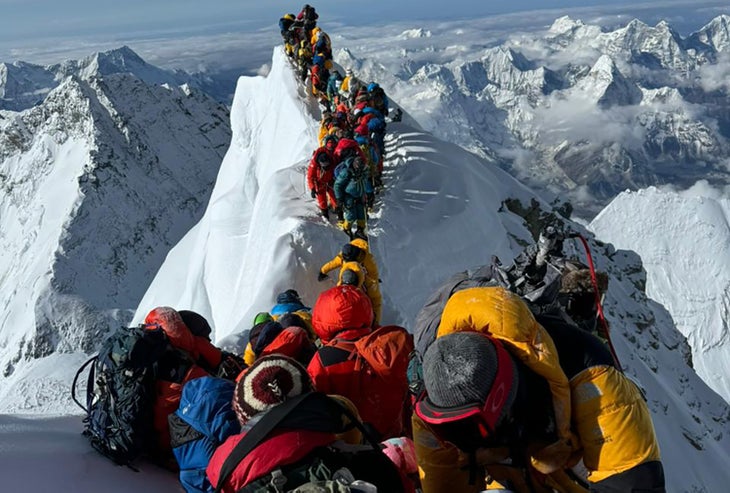
But not everyone follows the guidelines during every moment of the ascent. And guides often look for ways to save time on the peak—limited oxygen puts a premium on a speedy ascent and descent. Some guides simply attach themselves to their clients and opt not to clip into the fixed safety ropes to bypass traffic. We may never know what caused two climbers to tumble down the ledge without being clipped into the safety rope. But sources told ���ϳԹ��� that it’s not uncommon for climbers to quickly unclip from the rope, navigate traffic, and then clip back in.
Cornices and snow often collapse on the high peaks—something guides call “objective danger,” or a risk that’s simply inherent to the mountain and cannot be completely eliminated. But Himalayan experts told ���ϳԹ��� that the deadly collapse on May 21 was still shocking. Billi Bierling, Everest summiteer and director of the Himalayan Database, an online archive of expeditions, said she’d never heard of a fatal accident of this nature. “I’ve never heard of it near the summit, and I’ve been doing this job for more than 20 years,” she said. “But maybe this is what is happening with climate change, and with it getting warmer. Maybe it was not necessarily only too many people, but also the warm temperature that made this thing collapse.”
Paralysis at 28,000 Feet
Baumgartner and others who had witnessed the collapse stood on the summit ridge in shock. Those nearest the accident site helped pull the four climbers up on the fixed ropes—they had tumbled approximately 30 feet below the ridge. Others watched in silence. Baumgartner wondered if what he’d just seen was real.
“After three or four minutes I saw the people that were clipped to the rope start to climb back up,” Baumgartner said. “Then I realized that we were all kind of stuck because the mountain broke away.”
The delay stretched on for ten minutes, then 15, then 20. Nobody could see where the two missing climbers had fallen, but it appeared that they’d disappeared over the Kangshung Face. Malla said the group seemed to be paralyzed—should they look for the two missing men or continue down the peak?
“In the death zone, search and rescue isn’t always possible,” Malla said. “Besides, there wasn’t any point as they were definitely dead.”
Malla realized that one of the missing men was a Nepali guide named Pas Tenji Sherpa who, just minutes before, had stood alongside him on the summit. Malla said Pas Tenji had reached the top of Everest wearing a white baseball cap on his head—a testament to the balmy conditions. His climbing client—later identified as 40-year-old British climber Daniel Paul Paterson—had been wearing an oxygen mask, but Pas Tenji had not, Malla said.
“He was obviously very strong because he was guiding his client without using oxygen himself,” Malla said. “He was a young guy, very talented.”
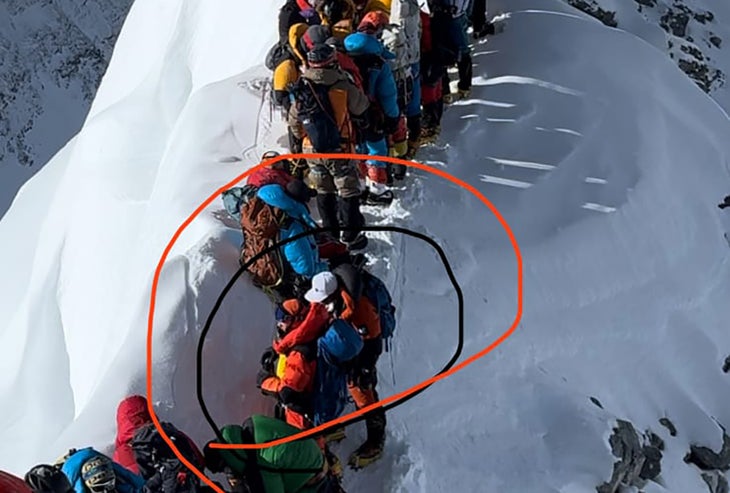
Malla had glimpsed Pas Tenji’s white baseball cap navigating through the crowds near the Hillary Step just moments before the collapse. Now, both Pas Tenji and Paterson were nowhere to be found.
Malla believes Pas Tenji and his client must have briefly unclipped from the fixed ropes to overtake slower climbers at the exact moment the cornice collapsed. “He and his client were passing on the outside of the cornice that came off the ridge,” Malla said. “He had likely attached his safety line to his client when it collapsed.”
Raising Funds for a Search
News of the deadly collapse spread quickly from Camp IV down to Everest Base Camp. Pas Tenji had been guiding for operator 8K Expeditions, which organized a team of climbers to sweep the summit ridge for the missing men. But the search came up empty. On May 26, attempts to locate the two were suspended.
Paterson’s partner, Beck Woodhead, launched a GoFundMe page in the days following his disappearance. The proceeds, she wrote, would offset the costs of a recovery mission to bring his remains home.
“He is known for his adventurous spirit, his kindness, and his unwavering dedication to helping others,” Woodhead wrote on the page. “Now it is our turn to help him.”
Sources have confirmed that efforts are underway to secure permission from the Chinese government to search the Kangshung Face with helicopters flown from the Nepal side. But China is historically a tricky partner in recovery missions for international climbers. Sources told ���ϳԹ��� that the mission will require coordination between the Nepal, China, and UK governments.
“It is going to be difficult to search for them because they have fallen on the Tibet side which needs coordination,” Khim Lal Gautam, an official with the Nepal Department of Tourism, .
A Ticking Clock near the Summit
As more climbers ascended the ridge, the traffic jam at the Hillary Step grew longer on both sides of collapsed cornice. But nobody wanted to climb down, Malla said. He snapped photos of the logjam—but he knew he had a responsibility to get his client to lower elevation.
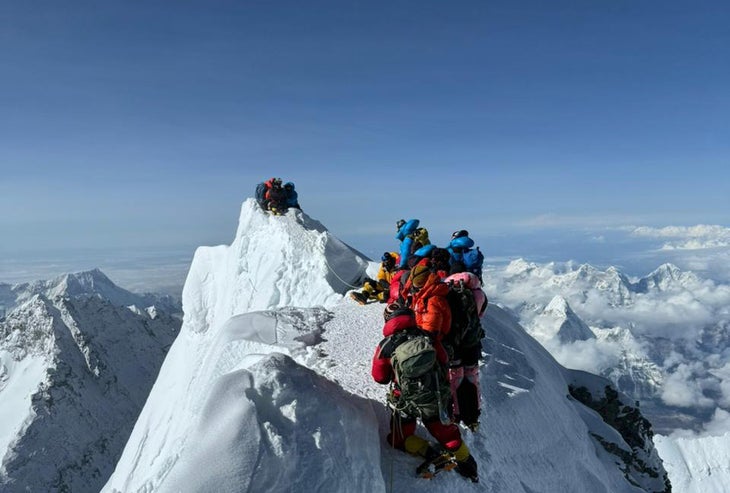
“Nobody wanted to move. Nobody had the courage,” Malla said. “We were all running out of oxygen. I realized that I had to do something. So I moved forward and started breaking a new trail.”
Malla walked around the waiting climbers and affixed himself to the now-empty rope. He slowly moved across the steep face, kicking footsteps in as he went. Once he reached the other side, one climber followed, then another. In his eyes, Malla helped prevent a greater tragedy atop the peak. Had climbers continued to stand around in shock, some could have run low on oxygen and died.
After a few minutes, it was business as usual on Everest once again. Malla and his client descended to Camp III where they spent the night and continued down to Base Camp.
Baumgartner and his team took a brief rest at Camp IV and continued all the way to Base Camp. After witnessing the disaster, he had one objective in mind.
“I just wanted to get off the mountain,” he said.


